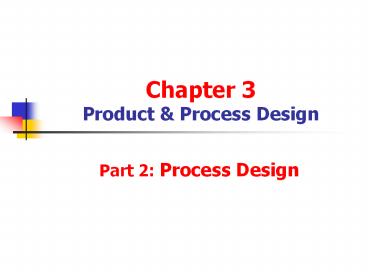Chapter 3 Product - PowerPoint PPT Presentation
Title:
Chapter 3 Product
Description:
Chapter 3 Product & Process Design Part 2: Process Design Product vs. Process Design Which comes first: Design of process or Design of product? The answer is ?? – PowerPoint PPT presentation
Number of Views:48
Avg rating:3.0/5.0
Title: Chapter 3 Product
1
Chapter 3Product Process Design
- Part 2 Process Design
2
Product vs. Process Design
- Which comes first
- Design of process or
- Design of product?
- The answer is ??
3
Product Strategy
- Once a company decides to produce a given product
or offer a particular service, company should
decide if product or service is to be - Made-to-order
- Assemble-to-order (or Built-to-Order)
- Made-to-stock
4
Make-to-order
- Products/services that are made to customers
specs but only after an order is received. - Product/service is customized
- Volume is ??
- Inventory level is ??
- Delivery timefrom time order is place to time it
is received--is generally ??
5
Make-to-order
- Examples
- Custom built home or office building
- Tailor made suit
- Commercial airplane
- Wedding cake
- Professional services (law case, prescriptions,
some medical procedures, etc.) - Hair styling
6
Assemble-to-order (built-to-order)
- Standard components are produced in anticipation
of demand. - Once an order is received, components can be
combined in different ways to accommodate
different customer specs. - Some customization
- May have what type of inventory?
- Delivery time shorter than make-to-order.
7
Assemble-to-order (built-to-order)
- Examples
- Computers (Dell)
- Standard vacation packages
- Track homes
- Cars built to customers specs
- Omelet
8
Make-to-stock
- Products produced for immediate sale or delivery
in anticipation of demand. - Product is standardized.
- Produced in large volumes.
- May have what type of inventory?
- Instant or short delivery time.
9
Make-to-stock
- Each unit is produced or assembled by going
through same series of operations in same order.
10
Make-to-stock
- Examples
- Off-the-shelf items
- Big ones
- Cars
- TV sets
- Small ones
- Toothpaste
- Candy
11
Overview of Product Strategy
Bake
12
Product Strategies
- Differ by
- Degree of customization
- Type of inventory
- Delivery time
- Volume
- Type of process (later)
13
Comparison of Product Strategies
Make to Order Assemble to Order Make to Stock
Custom-ization Very high High Low
Type of inventory None WIP Finished goods
Delivery time Long Moderate Instant or Very Fast
Volume Low Moderate Very high
Process Project Batch Line or continuous
14
Types of Processes
- What type of process is best for each type of
product strategy? - Processes can be classified as
- Project
- Batch
- Line
- Continuous
15
Project Process (Custom Job Shop)
- A process set that makes a one-at-a-time product
exactly to customer specifications. - Product has its own unique processing
requirements. - Product is routed to different operations
(workstations), depending on its own unique
needs.
16
Project Process (Custom Job Shop)
- High degree of customization
- Low volume
17
Project Process
- Construction, some medical procedures,
landscaping, custom built home, tailor made suit. - Therefore, use with products that are make to
order.
18
Batch Process
- Produces small quantities of a product in groups
or batches based on customer orders or specs. - Product is often made using standard components,
which are combined in different ways, depending
on product requirements.
19
Batch Process
- Print shop, computers (Dell), education classes
- Works best for products that are
assemble-to-order.
20
Example of Layout of a Project or Batch Process
Hospital
21
Line process (or assembly line)
- Produces large quantities of a standardized
product. - Assembly line operation designed for mass
production. - Each unit is produced or assembled by going
through same series of operations performed in
same order. - Cars, off the shelf items.
- Works best for make-to-stock products.
22
Continuous Process
- Very high volumes of a fully standardized product
- Product is continuous liquid or gas
- Oil refinery
- Water purification plant
- Liquid chemicals
- Capital intensive and automated
- Use for make-to-stock products
23
Example of Repetitive Process Car Wash
Dry
Rinse
Soap
Spray
24
Example of Line Process Hotel Laundry
25
Classification of Processes
Project Batch Line Continuous
Intermittent Intermittent Repetitive Repetitive
26
Processes Characterized by Relationship Between
Standardization and Volume
27
Intermittent vs. Repetitive Processes
28
Types of Processes vs. Product Strategy
Types of Process Product Strategy
Project Made to order
Batch Assemble to order
Line Make to stock
Continuous Make to stock
29
Process Performance Metrics
- To determine if a process is functioning
properly, we must measure its performance. - To measure performance, process should be in
statistical control.
30
Process Performance Metrics
31
Process Velocity
- Should ratio be big or small?
- What does a ratio of 1.0 imply?
- Greater than 1.0?
32
Utilization
- Should ratio be big or small?
- What does a ratio of 1.0 imply?
- Less than 1.0?
33
Efficiency
- Should ratio be big or small?
- What does a ratio of 1.0 imply?
- Less than 1.0?
- Greater than 1.0?
34
Example Page 72, text
- A title company is analyzing its operations in an
effort to improve performance. - The following data has been collected
35
- It takes an average of 4 hrs. to process and
close a title. - Value added time is estimated at 30 minutes per
title. - Each title officer is on payroll for 8 hrs. per
day, but works 6 hrs. per day on average,
accounting for lunches and breaks. - Industry standard for labor utilization is 80.
36
- The company closes 8 titles per day.
- Industry standard at comparable companies is 10
titles closed per day. - Compute
- Process velocity
- Labor utilization
- Efficiency
37
Process Velocity
38
Labor Utilization
39
Efficiency

